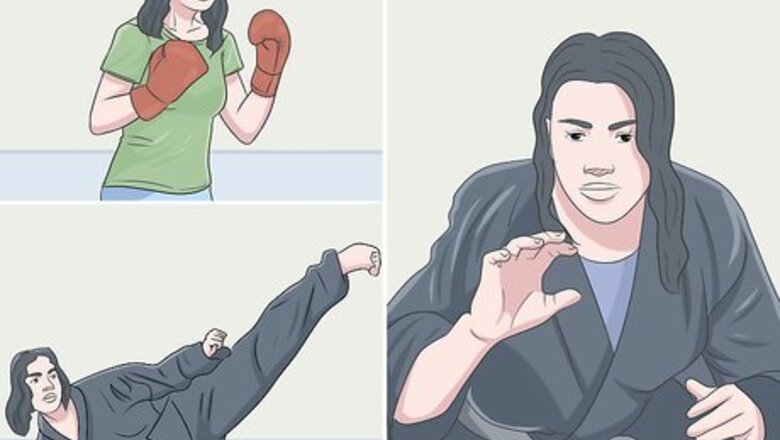
views
Choosing Your Training Plan and Facility

Choose one type of martial art to specialize in if you prefer to master one task at a time. Many of the most successful MMA fighters spend years specializing in one martial art before branching out into other disciplines. If you prefer to hone one skill set before moving on to the next, consider picking one martial art to train in first. After you’ve developed a strong foundation, you can start adding additional martial arts into your practice. Boxing and kickboxing can provide a solid foundation for basic hand and footwork as well as critical striking skills. Muay Thai is very helpful for basic striking, handwork, and footwork. Karate and Kung Fu can help improve your strikes and accuracy in stand-up fighting. Taekwondo is one of the broadest forms of martial art study and can provide a well-rounded base of fighting skills. Wrestling teaches skills that are very important in controlling your opponents to the ground. Judo helps you leverage your opponent to the ground and gain a good position once there. Brazilian Jiu Jitsu (BJJ), seen by many as one of the most critical disciplines of successful MMA fighting, teaches body control and ground defense.
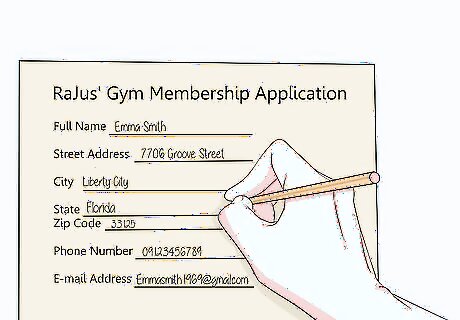
Sign up for an all-encompassing training program if you want a more well-rounded experience. MMA fighters need to be skilled at stand-up fighting, grappling, and groundwork to be successful, so many younger fighters are choosing to train in a range of disciplines rather than specializing in one fighting style. If you prefer more varied training, look for MMA gyms that offer classes in a variety of fighting techniques.

Research gyms in your area. If you want to train in one specific martial art, look for gyms that focus in that discipline or are led by an ex-professional fighter that specializes in it. If you’re looking to become a very well-rounded fighter, try searching for a gym that offers classes and trainers in a range of disciplines. There are many online resources to help find MMA gyms, including https://www.findmmagym.com and https://www.fightresource.com. If you can’t find a general MMA gym in your area but want a more well-rounded experience, try looking for classes in specific martial arts and combining them to create your own schedule.

Speak with coaches or instructors about your goals. Think about what you want to achieve through your MMA practice. Are you simply looking to work up a sweat or are you hoping to pursue a career as a professional fighter? Whatever your goals, your instructors can help you develop the right plan to get there. No matter what your specific goal, tell your instructors about your current fitness background and experience with fighting, as well as any injuries or physical restrictions. You’ll also want to let them know how much time you’re able to commit to training.
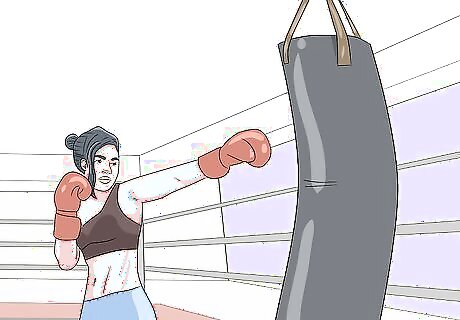
Try out different types of classes. Before committing to a gym, ask if you can attend a free or reduced-price trial class. Gym memberships can be expensive, so it’s important to know that you like the type of fighting, instructors, and atmosphere before committing. If you're interested in a well-rounded training experience, make sure to sample multiple classes at a gym before purchasing a membership. You don't want to take a kickboxing class and sign up for a year-long membership only to find that the Jiu Jitsu instructors are subpar!
Adopting a Training Regimen

Get protective gear to cover areas like your hands, head, and shins. Having the proper protective gear can help prevent injuries and make you a better fighter. If you’re training at a gym, they may be able to provide some gear, but make sure to ask what you should bring yourself. Some basic gear may include: MMA gloves, also called grappling gloves, and/or boxing gloves. Handwraps. Headgear, usually covering the top and sides of your head but sometimes covering the entire face. Mouthguard. Shinguards. Rashguard long-sleeve or short-sleeve shirt.

Go to classes regularly. Practicing frequently is the key to improving, especially when you’re first starting out and have a lot to learn. Remember that everyone at the gym is there to learn and improve, so try not to be discouraged if you have a difficult class. Many competitive fighters train for 3-5 hours a day, 5 days a week. However, this isn't practical for everyone, so you should train according to your goals and as frequently as your schedule and body allow.

Spar with your classmates. Practice fights with your peers can help to hone your skills and improve your abilities. Be sure to communicate with your sparring partner about your preferred intensity and skill level. Learn how to tap out or submit (yield the fight to your opponent) in order to avoid injury.
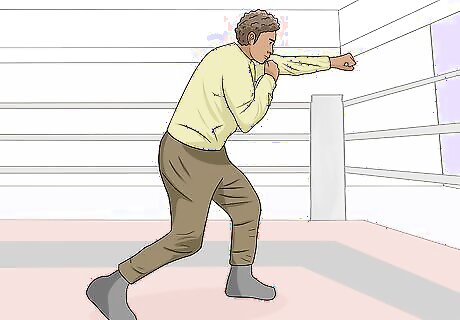
Practice fighting skills on your own with shadow boxing or a punching bag. If you have difficulty getting to a gym or simply want increase your skills outside of class, try practicing hits on your own. A basic online search can help you find videos, guides, and other resources to refine new techniques. Shadow boxing involves practicing your hits by punching the air. Shadow boxing in front of a mirror is an easy way to observe and tweak your form. With or without a punching bag, practice basic punches like the jab, cross, and hook, as well as front, side, and roundhouse kicks. You can also work in combination moves, such as a jab-cross or cross-front kick. Some fighters prefer to practice in short bursts (30-60 seconds), taking a break in between more intense rounds. Others work at lower intensity for 3-5 minutes to simulate an actual MMA fight. Try multiple methods to see what works best for you.
Do some strength training. Lifting weights and doing bodyweight exercises can put more power behind your punches and kicks. It can also improve your stability and increase your resistance to attempts to take you down.
Strengthening your core is critical to improving your kicks, punches, and throws. Try bodyweight exercises like crunches or V-sits to begin and gradually incorporate resistance through weights or bands as your core strength improves. Up-down exercise, like burpees, can be especially helpful for building fight strength and preparing to combat opponents attempts to take you down.
Add in cardio sessions. No training regimen is complete without working on your endurance since even the strongest fighter will be unsuccessful if they tire after the first punch.
While running is an easy way to improve your fitness level, there are plenty of different ways to get cardio exercise, including cycling, swimming, rowing, jumping rope, and many more. Try to add a few minutes onto your workout each session to increase your stamina and endurance.

Maintain a healthy diet to fuel your training. Professional MMA fighters can spend months perfecting their diet plans, but even amateur trainers can benefit from a diet rich in proteins, fruits, vegetables, and healthy fats. Try limiting simple carbohydrates and make sure to consume plenty of water before, during, and after training sessions. Eating 5-6 small meals throughout the day can help to increase metabolic activity and speed muscle growth, supporting your MMA training process. Protein is critical to building and maintaining muscle. When you’re training, aim to get 0.5 to 0.9 g of protein per 1 pound (0.45 kg) of bodyweight per day. So, for example, if you weigh 150 pounds (68 kg), you should consume between 75 g and 135 g of protein daily.

Consult with a medical professional after serious injuries. MMA fighting can lead to physical damage, especially if you train unsafely, don’t use the proper equipment, or try to push through injuries. Be sure to visit a doctor after any major injuries, particularly if you suspect you may have broken a bone or suffered from a concussion.
Fighting in Tournaments and Competitions

Wait until you and your coaches agree you’re ready to fight. Rushing into your first fight is an easy way to find yourself in a “shark vs. fish” match, in which you’re paired against someone high above your skill level. Your instructors can help determine when you’ll be ready for your first competition and develop a plan to get you there. Due to differences in athletic background, physical ability, and time available for training, the amount of time it will take to prepare for a first fight can vary dramatically from person to person.

Sign up for an amateur competition and review the rules. Your gym or trainer can usually help you find and register for the right organized competitions. Once you find a tournament you’re interested in, make sure you meet the requirements. Few fights allow anyone under the age of 18 to participate and most competitions divide fighters into different classes based on gender, age, size, and skill level. Once you turn pro, you can no longer compete at the amateur level, so make sure you have enough experience to protect your safety and reputation before moving up a level.
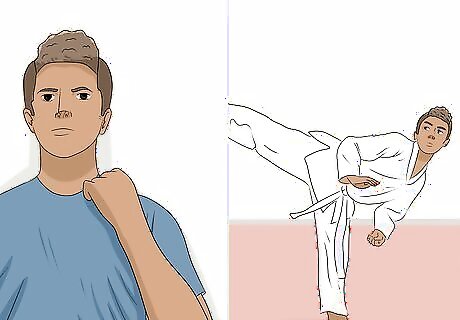
Prepare for the fight both mentally and physically. If possible, evaluate your opponent and develop a strategy in advance. For example, if your opponent is great at stand-up fighting, work on your take-down moves to lessen their advantage. Before the fight itself, make sure to get plenty of rest and fluids. Many fighters will reduce their training in the week or days before the fight. This can help give your muscles a break and ensure you’re fresh for the big moment.

Cultivate the right mental attitude, even after a defeat. Competition is as much mental as it is physical and even the best, most experienced fighters lose sometimes. Learn from your mistakes and use defeat as a motivator to continue improving. Displaying a self-confident, aggressive attitude can also help you intimidate and dominate your opponent on the mat. Some fighters motivate themselves by getting angry at their opponents before a fight, while others prefer to think about fights as opportunities to display their hard-won skills.

Work on showmanship and self-promotion if you’re planning to go pro. Name recognition is important for success since your worth as a professional fighter (including your pay) is largely determined by your ability to draw an audience. Develop and cultivate a unique persona to attract attention. Creating a presence on social media can help get your name out there. Share your story on Facebook or Instagram and connect with other MMA fighters and fans. When you're ready, you can use social media to call out other fighters and potentially book some higher profile fights.



















Comments
0 comment